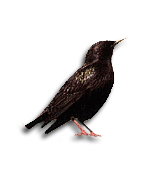General Characteristics:
- The European Starling is a very common species of bird found throughout North America
- Mostly black in colour with a speckled appearance on the feathers of body and short tail
- The Adult beak is bright yellow and immature birds have a dark beak, longer tail, and less markings
Reproduction:
- Starlings mate in the spring
- Females lay 4-7 eggs (March to July) which hatch after 12 days of incubation (1 clutch)
- 2-3 clutches per season
- Young will leave the nest from 21 days old
Signs of Infestation:
- Starlings are a pest bird species because they nest in the city and suburban areas
- They flock to city areas in search of food and nesting sites like commercial signs and billboards to over-winter
- They often displace native hole-nesting songbirds from their nesting areas. They consume a variety of foods such as insects, invertebrates, fruits, seeds, nuts and numerous human waste scraps found
- Starling vocalizations and excessive filth produced from feces can be extremely disruptive to building owners
- In large tree roosts, their droppings damage or even kill trees
- They can fly 15-30 miles between roosting and feeding sites
Control Techniques:
Several methods of control are available for this pest bird species. A professional inspection is highly recommended. Some control methods to consider are:
- Exclusion of all attractive nesting sites on and around structure
- Sealing all cracks and openings in structure can be helpful
- Netting is effective and commonly used in receiving areas, overheads and building entry/exit points
- Flashing light and/or noise deterrents can be effective in some situations
- Broken windows in upper areas of buildings should be sealed
- Spaces between air conditioners and building should be sealed
- Building rooftop ventilators should have netting overtop to prevent birds from nesting
- Large warehouse entrances used for forklift operation can be blocked from birds using hanging clear plastic strips. This allows day to day operations to continue while deterring a variety of bird species
- Commercial signs should have no existing gaps or spaces behind them to reduce harbourage
Please click here to contact a Focus Pest Control professional to inquire about further treatments for this pest species.
References:
Benett, Gary W., et.al.. Truman’s Scientific Guide to Pest Control Operations. Duluth: Advanstar
Communications, 1988. Pp. 357-359.
Chow, J. 2000. "Sturnus vulgaris" (On-line), Animal Diversity Web. Accessed May 15, 2009 at
http://animaldiversity.ummz.umich.edu/site/accounts/information/Sturnus_vulgaris.html.
Disclaimer:
The Focus Pest Control ‘Pest Library’ is an educational resource written largely to educate the general public about common pests in Ontario. The Focus ‘Pest Library’ does not include all species in Ontario, nor does it include the most recent scientific data about species we describe. Though we edit our accounts for accuracy, we cannot guarantee all information in those accounts. While Focus Pest Control staff and contributors provide references to books and websites that we believe are reputable, we cannot necessarily endorse the contents of references beyond our control.
(Back to top)
|


